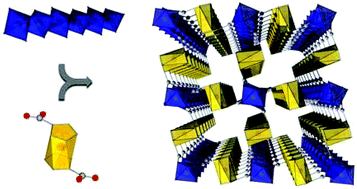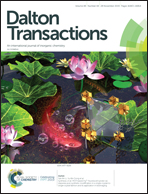A porous and redox active ferrocenedicarboxylic acid based aluminium MOF with a MIL-53 architecture†
Abstract
A metallocene based linker 1,1′-ferrocenedicarboxylic acid (H2FcDC) was used to synthesise the first permanently porous ferrocenedicarboxylate, exhibiting a MIL-53 architecture. This compound Al-MIL-53-FcDC [Al(OH)(FcDC)] is obtained in glass vials under mild synthesis conditions at ≤100 °C and after a short reaction time of 90 min. The crystal structure was determined from powder X-ray diffraction data and the compound shows porosity towards N2 and H2O, exhibiting a BET surface area of 340 m2 g−1. Furthermore, the MOF was characterised via EPR and Mössbauer spectroscopy. The Mössbauer spectrum of Al-MIL-53-FcDC shows a characteristic doublet with an isomeric shift of 0.34 mm s−1 and a quadrupole splitting of 2.39 mm s−1, proving the persistence of the ferrocene moiety. A negligibly small amount of impurities of ferrocenium ions could be detected by EPR spectroscopy as a complementary technique. Cyclic voltammetric experiments demonstrated the accessible redox activity of the linker molecule FcDC2− in Al-MIL-53-FcDC. A reversible oxidation and reduction signal (0.75 V and 0.64 V, respectively, vs. Ag) of FcDC2− was observed and maintained during forty CV cycles, while the crystallinity of the MOF remained unchanged after the experiment.



 Please wait while we load your content...
Please wait while we load your content...